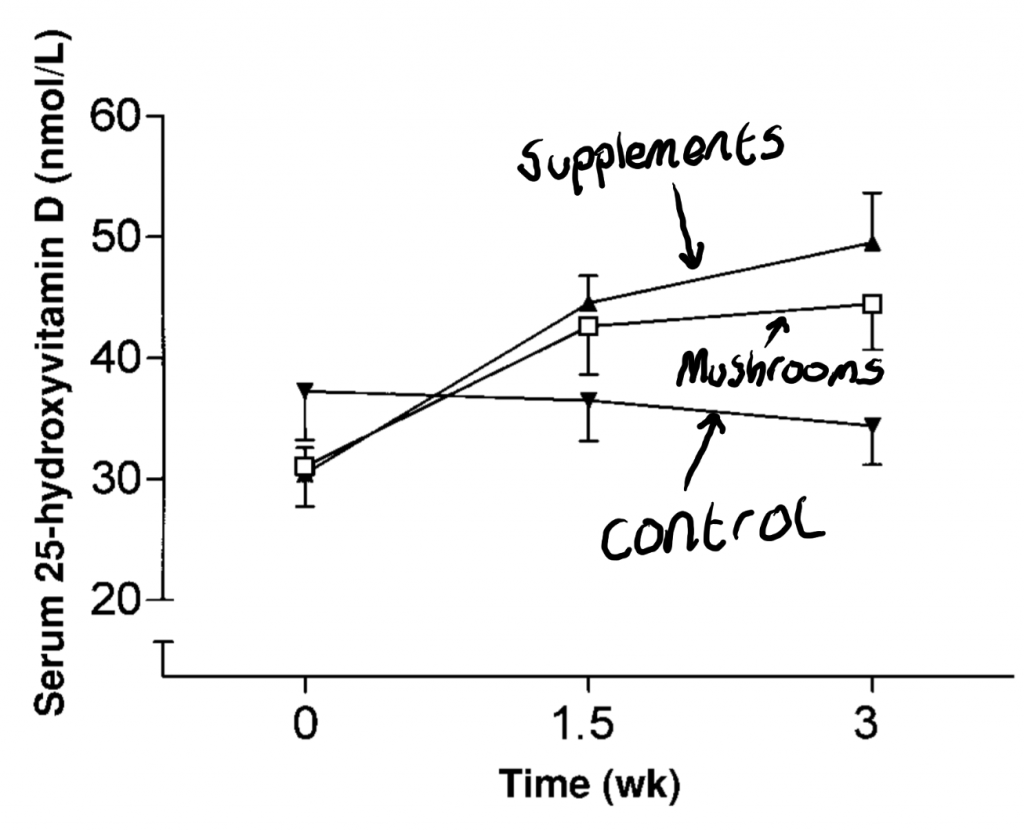 Evidence suggests that mushrooms can be a source of dietary vitamin D. In particular, mushrooms are rich in ergocalciferol, also called vitamin D2. Ergocalciferol is known to be biologically active in humans, and a number of studies have investigated the ability of humans to absorb the vitamin D from mushrooms. For example, in one study researchers fed human subjects wild edible mushrooms (Cantharellus tubaeformis) and then measured the rise in serum 25-hydroxyvitamin D [25(OH)D] as a marker for absorption. All subjects had serum 25(OH)D levels below 60 nmol/L at baseline. Subjects consumed either mushrooms containing 14 μg ergocalciferol, a supplement containing 14 μg of ergocalciferol or no supplementation. After 3 weeks of consuming the mushrooms or supplements for 5 days per week, the mushroom and supplement group showed significant increases in their serum 25(OH)D concentrations compared to the subjects consuming no mushrooms or supplement (see graph).
Evidence suggests that mushrooms can be a source of dietary vitamin D. In particular, mushrooms are rich in ergocalciferol, also called vitamin D2. Ergocalciferol is known to be biologically active in humans, and a number of studies have investigated the ability of humans to absorb the vitamin D from mushrooms. For example, in one study researchers fed human subjects wild edible mushrooms (Cantharellus tubaeformis) and then measured the rise in serum 25-hydroxyvitamin D [25(OH)D] as a marker for absorption. All subjects had serum 25(OH)D levels below 60 nmol/L at baseline. Subjects consumed either mushrooms containing 14 μg ergocalciferol, a supplement containing 14 μg of ergocalciferol or no supplementation. After 3 weeks of consuming the mushrooms or supplements for 5 days per week, the mushroom and supplement group showed significant increases in their serum 25(OH)D concentrations compared to the subjects consuming no mushrooms or supplement (see graph).

Ergocalciferol causes increases in blood (serum) levels of 25-hydroxyvitamin D. Food sources of ergocalciferol, such as mushrooms, appear to show similar rises in blood 25-hydroxyvitamin D compared to supplements (dose for dose). The ergocalciferol content of mushrooms can be increased via exposure of the mushrooms to ultraviolet light, and so mushrooms may be an effective functional food for the provision of food sources of vitamin D. However, cod liver oils still remain the most reliable and consistent dietary source of vitamin D.
Therefore the ergocalciferol from mushrooms may show similar bioavailability to the ergocalciferol from supplements, as no significant difference in serum 25(OH)D was observed between the mushroom and supplement groups. However, ergocalciferol may be less bioavailable when compared to cholecalciferol (the animal form of vitamin D), also called vitamin D3. This reduction is bioavailability may stem from a more rapid metabolism of ergocalciferol, which appears to follow a slightly different route of metabolism and excretion compared to ergocalciferol (here and here). That is not to say that ergocalciferol is not useful, as clearly it is able to increase plasma levels of 25(OH)D. However, ergocalciferol raises levels of 25-hydroxyvitamin D2 [25(OH)D2]. As 25(OH)D2 rises, there may be a concomitant suppression of 25(OH)D3, due to competition for metabolising enzymes. The effects of this are not understood, and it is unclear whether this has long term implications for vitamin D status.
Eat Well, Stay Healthy, Protect Yourself
RdB
